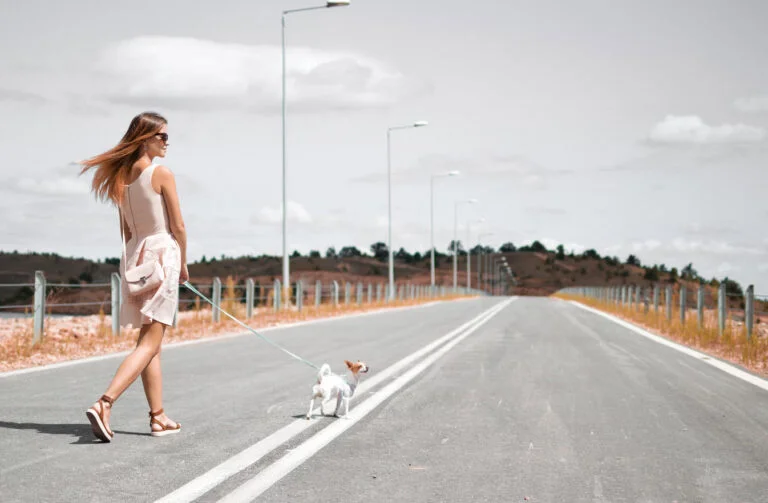It would be best to enjoy walking with your dog as much as your furry friend does. But if your dog tugs at the leash, pauses to smell every blade of grass, or chooses to go after something unexpected, it may soon become a problem.
We’ve found that learning about your dog’s behavior and practicing a few valuable tricks can make your walks less stressful and more fun.
These are eight suggestions to make your walks with your dog more enjoyable.
1. Use a leash at all times.
A leases a safety precaution and a tool for control. Dogs follow their noses and are inherently curious. Without a leash, your dog might rapidly lose sight of their whereabouts as they dries off and chases an intriguing smell. Even the most well-mannered dog might suddenly become sidetracked and runoff.
A leash keeps you and your dog safe by keeping your dog in check and close at hand. To avoid mishaps, selecting a leash that fits your dog’s size and strength is critical.
2. Verify That Your Dog Is Correctly Identified
Regardless of your level of caution, there’s always a potential that your dog may untie themselves from the leash or fall out of their collar. Make sure your dog is correctly identified in advance of this.
You must wear a collar with an ID tag and your current phone number. Additionally, think about implanting a microchip beneath your dog’s skin. This elegant identification serves as a fallback if the collar is removed. Most vets and animal shelters can readily scan microchips, which makes it simpler to get you and your missing dog back together.
3. Refrain from pursuing your dog if they escape.
Avoid chasing your dog if it manages to escape its leash and run off. For your dog, chasing may become a game that motivates it to run farther. Try contacting them instead, pretending to have their favorite toy or reward, or speaking in a soothing, upbeat tone. Attach a long nylon rope to your dog’s collar during training sessions if it doesn’t return immediately.
Just before they reach the end of the line, issue the order “Whoa” or “Stop” and secure the other end to something substantial. You can avert future runaways by teaching your dog to stop and return to yoregularlyis.
4. Make Use of Body Language and Consistent Commands
Dogs obey consistent orders and understand clear body language more readily than words. Your body language and the tone and intonation of your speech convey a lot to your dog. Give orders with firmness without being rude.
To avoid confusion, you only provide various orders for the same behavior. For instance, if you want to utilize “Sit,” don’t switch between it and “Down.” Training becomes more successful when there is consistency, and your dog knows what is expected of them.
5. Bring “Poop Bags” for Trash Removal
You are cleaning up after your dog is one of the less glamorous parts of dog walking. But it’s a crucial component of owning a dog responsibly. To keep your area tidy and to prevent unpleasant surprises on your next stroll, always keep poop bags on hand for cleaning up after your dog.
Two helpful tips are to reuse the plastic bags your newspaper arrives in or buy easily transportable, eco-friendly, biodegradable dung bags.
6. Recognize the Territorial Nature of Your Dog
Since dogs are territorial animals, marking their territory is something they do naturally. For this reason, while you stroll, your dog can feel compelled to spray every tree, shrub, and post. Stopping repeatedly might be annoying, but remember that this is an instinctive tendency. It’s how your dog interacts with other canines nearby.
Set limits to keep the walk going, but give your dog space to explore and identify their territory rather than dragging them away from every smelling location.
7. Regulate Allergies via Frequent Grooming
Brushing or washing your dog before returning inside after a walk will help lessen the amount of pollen and other allergens that stick to their coat, especially if you or someone else in your home suffers from allergies.
Frequent grooming helps reduce the allergens your dog brings into your house and keeps it clean. If your dog has been playing in the dirt or sprinting over the grass, clean it with a moist towel before bringing it inside.
8. Employ Positive Reinforcement to Stop Excessive Barking
Dogs naturally bark, especially when they see something or someone they don’t know when out for a stroll. Excessive barking, nevertheless, may be bothersome. To handle this, give your dog permission to bark a few times before giving the order to be quiet.
If they keep barking, use a sudden stop, such as shaking a can of pennies or spraying them with water or Listerine in a squirt bottle. Give your dog a treat and some praise when they stop barking. Over time, this positive reinforcement will help your dog learn that staying quiet is good and will lessen his undesirable barking.
Conclusion
It’s sometimes easy to take your dog on walks. With these suggestions, you and your dog may have a great time on your regular walks.
Though not people, dogs still greatly desire to please their masters. Knowing your dog’s natural tendencies and giving firm yet compassionate orders will improve your walks and fortify your relationship with it.
So grab that leash and enjoy all that walking your dog has to offer, including exercise and the joy of their company.


